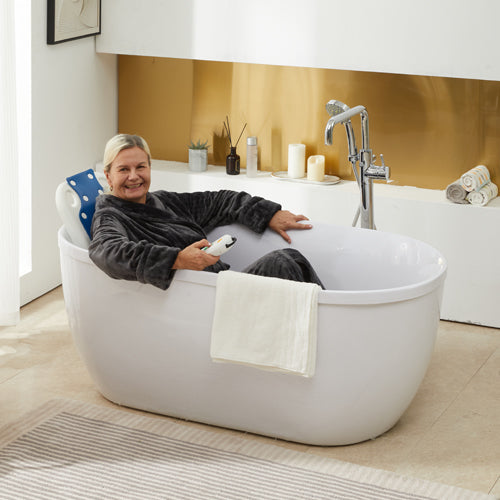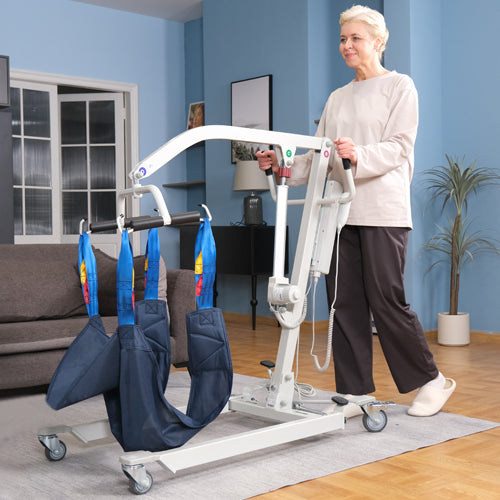Transport chairs and wheelchairs are among the most popular solutions for people with mobility issues. At a certain point, these devices can resemble each other. This is because both serve to deliver improved mobility to individuals with restricted movement, making it easier for them to get around. However, in reality, these devices appear very different in functionality, capabilities, and use scenarios. Learning the differences between a transport chair and a wheelchair can help ensure an appropriate decision for a patient, a loved one, or even yourself.
This article will discuss what each one offers and the main differences between the two. It will also explain how to choose what fits your needs best. We will mention two products from VOCIC—a manual and a powered option—so you can view examples of quality mobility devices. These products provide comfort, safety, and independence, while also focusing on user comfort in design.
What Is a Transport Chair?
A transport chair is a lightweight mobility aid primarily used for getting around and covering short distances. Transport chairs, unlike conventional wheelchairs, are generally smaller, with only four wheels, and must be pushed by another person. Due to this factor, it is not meant to be used independently, but rather when there are caregivers who can help with mobility. However, some models, such as those from VOCIC, are designed with added versatility, allowing the chair to function not only as a traditional transport chair but also as a rollator walker to support users in walking independently
One of the characteristics of transport chairs is that they are light, foldable, and store easily. They are best suited for journeys, check-ups, or getaways. The vast majority of models weigh between 15 and 30 lbs., and thus can be lifted into cars or carried upstairs. For individuals who want to move around without assistance, look for products that are designed to be operated independently by the user. This increases their applicability to individuals who wish to move around without support.
What Is a Wheelchair?
A wheelchair, in turn, is both independent and caregiver-friendly. It is divided into two broad categories: manual and powered. Manual wheelchairs have bigger hind wheels, which permit the user to travel by pushing off the edges of the wheels, whereas electric wheelchairs involve motors and batteries to be entailed as full independence with the operation of a joystick.
Wheelchairs are bulkier and sturdier than transport chairs and are more stable, comfortable, and functional. They suit those users who require assistance in mobility in the course of the day, both indoors and outdoors. Wheelchairs are often designed to be long-term products and therefore may include better safety mechanisms, adjustable parts, and larger weight limits. The setback is that they may be costly and not portable, as opposed to transport chairs.

Transport Chair Vs. Wheelchair: The Difference
When considering a transport chair vs a wheelchair, one can easily notice the difference in terms of weight, folding, usage, and cost:
-
Weight: The transport chairs are very light (15-30 lbs.) compared with manual wheelchairs (30-40 lbs.) or motorized wheelchairs (60 lbs. and above).
-
Foldability: They both are foldable, although transport chairs fold smaller, which makes them lightweight to carry and store.
-
Usage Scenarios: Transport chairs are better used at short-term outings, and temporary usage with the caregiver, and wheelchairs may be used daily, both outdoors and indoors.
-
Control Methods: Transport chairs can only be pushed by a caregiver, unless some flexible models allow independent use, like those from VOCIC. Manual wheelchairs can be pushed by the person on the chair, but powered wheelchairs have full independence due to the use of a joystick.
-
Price: Transport chairs are cheaper, averaging around $150-$300, compared to wheelchairs, which can cost hundreds of dollars to thousands of dollars: manual wheelchairs may cost around $200-$500, powered wheelchairs anywhere between $800 to several thousand dollars.
After all, Transport chairs are portability-convenience oriented, and wheelchairs are versatility-independence oriented.
Should I Choose a Transport Chair or a Wheelchair?
Whether you choose between the two depends on your lifestyle and daily mobility requirements. A transport chair can be the right choice when you search for an easy and lightweight chair to support your occasional outings. Nevertheless, in case you require the assistance of a mobility aid daily and desire a higher level of independence, the best option is to choose a wheelchair.
VOCIC U31: A Versatile 3-in-1 Manual Wheelchair
The VOCIC U31 3 In 1 Lightweight Foldable Manual Wheelchair is a good alternative to those who are inclined to choose a manual variant. This chair is priced at $259.00(discounted from $359.00), coined with three in one, it has functions of a manual wheelchair and a transport chair, and even a rollator walker all incorporated in one. It weighs only 38 lbs., and folds in 3 seconds, and will fit into most car trunks. It has a strong carbon steel folder, a brake system, and can support 300 lbs of weight, which makes it safe and convenient during both indoor and outdoor exercises.
The VOCIC U31 also emphasizes comfort with breathable, Oxford fabric seat and backrest, flip-back armrests, and removable footrests. It is also quite versatile and, therefore, it is a great product to choose when one is seeking flexibility in their mobility solution without straining the bank balance too much.
VOCIC V53: A Lightweight Powered Wheelchair
The VOCIC V53 Lightweight Foldable Power Wheelchair stands up best in cases of top priority put on independence and power. Priced at $899.00 (down from $1,199.00), the V53 is a blend of lightweight and durable power. It features the dual motors of 250W, a lithium battery with a range of up to 9.3 miles, and safety smart electromagnetic brakes.
Although this is a powered wheelchair, it only weighs 61.5 lbs. (with battery) and folds down to store in car trunks or in tight spaces. Its FDA II certification, in addition to the anti-tip wheels and long-lasting pneumatic rear tires, provides slip-resistant performance inside or outside. The model is more appropriate when dealing with people who look forward to freeing themselves and being able to navigate with ease.
With both of these options available (U31 and V53), VOCIC is making sure that their users can have stable choices, regardless of whether they will use an all-around manual chair or a high-tech powered one.

Summary
The transport chair vs wheelchair question is a matter of independence vs convenience. Transport chairs are easily foldable, mobile, and most suitable in case of temporary usage under caretaker facilitation, whereas wheelchairs, both manual and power-driven, assist in a habitual long-term setting, comfort, and freedom.
The VOCIC U31 Manual Wheelchair is also a highly recommended wheelchair, which offers supreme versatility at a low price. This VOCIC V53 Power Wheelchair offers independence, advanced features, comfort, physical security, and freedom of mobility to those who value it.
At the end of it all, the advantage comes down to your requirement, lifestyle choice, and freedom of wanting to depend on oneself. Transport chairs are essential, as well as wheelchairs, when it comes to quality of life and mobility.
FAQ
Can you use a transport chair like a wheelchair?
No, transport chairs are intended to be pushed by an attendant. They do not have the big back wheels to work with themselves. However, certain VOCIC models offer a unique design that allows them to also function as a rollator walker, giving users the option to operate them independently.
Which is easier to push, a wheelchair or a transport chair?
Transport chairs are usually easier to push because they are lightweight and more compact. Nevertheless, wheelchairs are more adaptable and give control to users, who seek independence.
Can either type be used on public transportation?
Yes, they can all be used in public transportation; however, wheelchairs (and powered wheelchairs in particular) may be restricted in various ways within different transportation systems. The local providers should always be checked to make sure that they comply with the requirements of accessibility.









